OnePlus 9 Pro vs Samsung Galaxy Note 20
We may earn a commission if you make a purchase from the links on this page.

With the OnePlus 9 Pro now released, offering a smooth 120 Hz display, superb performance and fantastic cameras made in partnership with Hasselblad, is it the better powerhouse phone to pick over the Samsung Galaxy Note 20? Or is the Note 20 holding up just fine against the 2021 OnePlus flagship?
Let's compare the two phones and see just how well they measure up against each other.
You may also find interesting:
The OnePlus 9 Pro with 256GB of storage can be purchased from OnePlus' website for $1,069.
The Samsung Galaxy Note 20 is currently selling for less – $999.99.
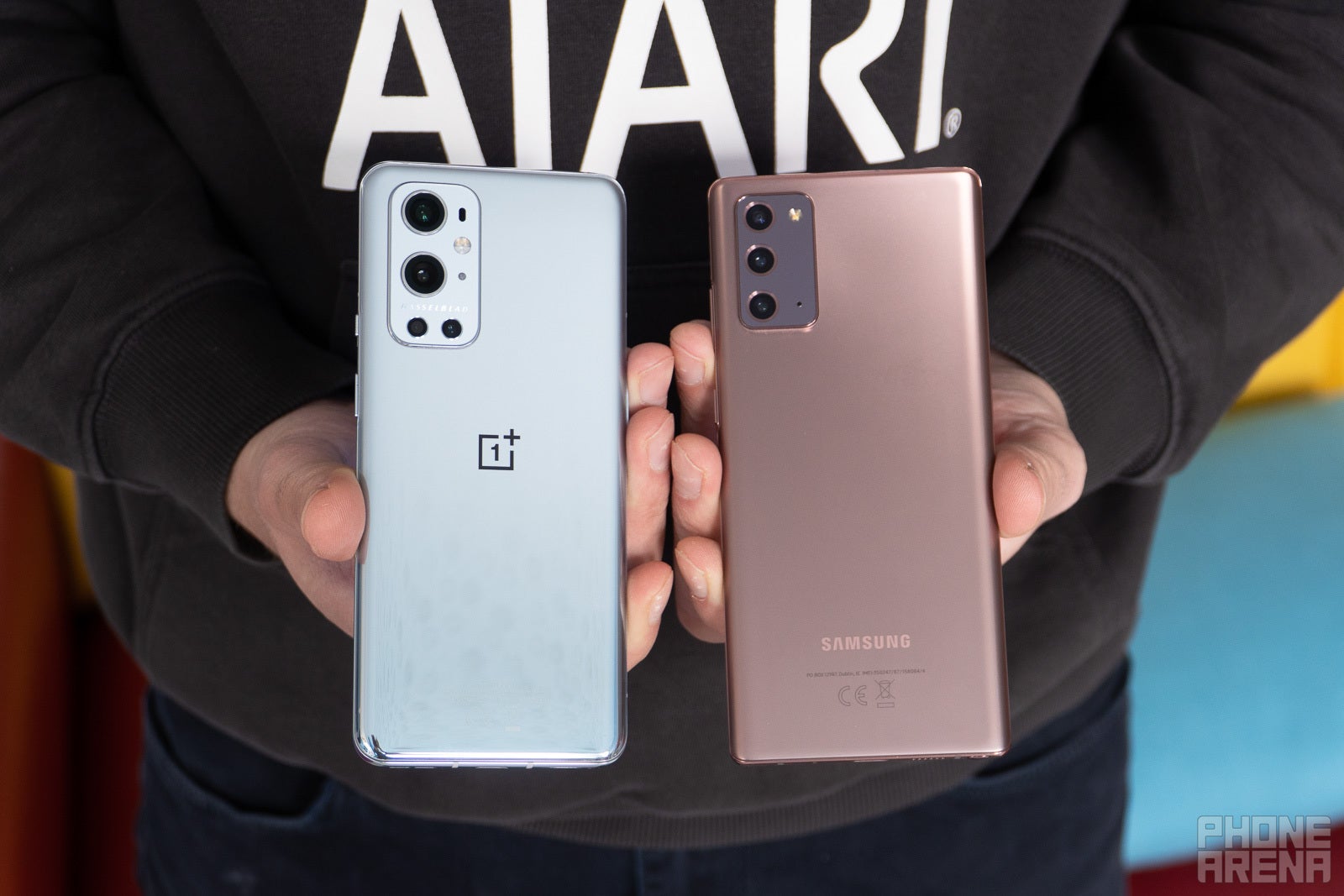
The OnePlus 9 Pro sports a fairly safe modern 2021 design, with minimal bezels around the display and a small hole punch selfie camera in its top left corner. On the back, its rather large Hasselblad-branded camera module catches the eye, but there's not much else but a OnePlus logo for flare.
The OnePlus 9 Pro features rounded corners all around, weighs just about 197 grams, and is glass on both sides, with a metal frame. Its color options are Stellar Black, Pine Green, and Morning Mist, all glossy.
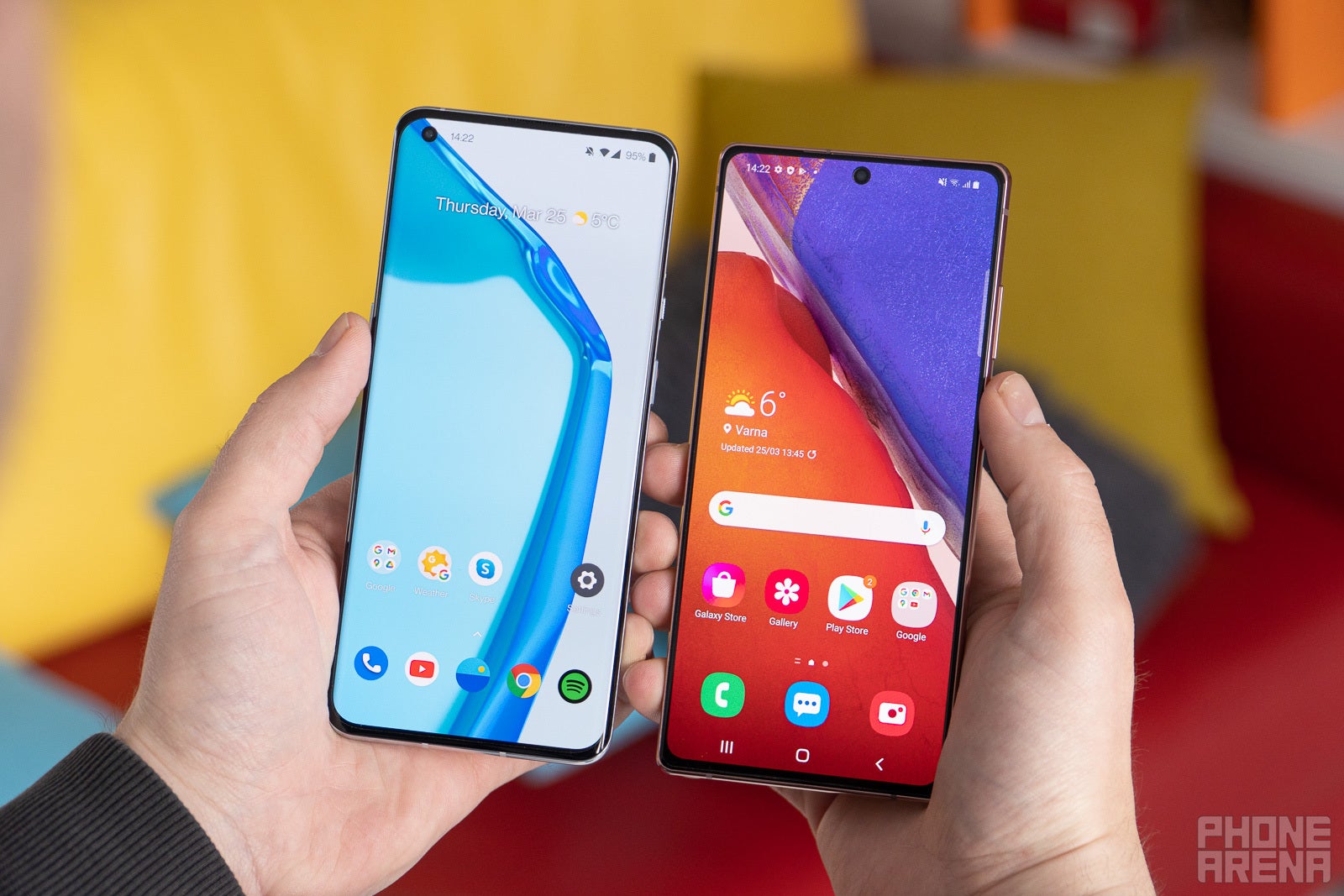
The Samsung Galaxy Note 20 too sports minimal bezels around the display and a small, centered hole punch selfie camera. Its back is a bit more lowkey and matte, although it too has an eye-catching camera module.
In terms of weight, the Galaxy Note 20 is actually the lighter phone out of the two, at 194 grams. Its plastic on the back and glass on the front, and comes in the following colors: Mystic Gray, Mystic Bronze, Mystic Green, Mystic Red.

The OnePlus 9 Pro has a 6.7-inch 120 Hz AMOLED display made by none other than Samsung, with a resolution of 3216 x 1440 pixels. The display is protected by Gorilla Glass and is satisfyingly sharp, vivid and bright. Its display refresh rate is actually variable, so to save on battery, it can dynamically change from 120 Hz all the way down to 1 Hz.
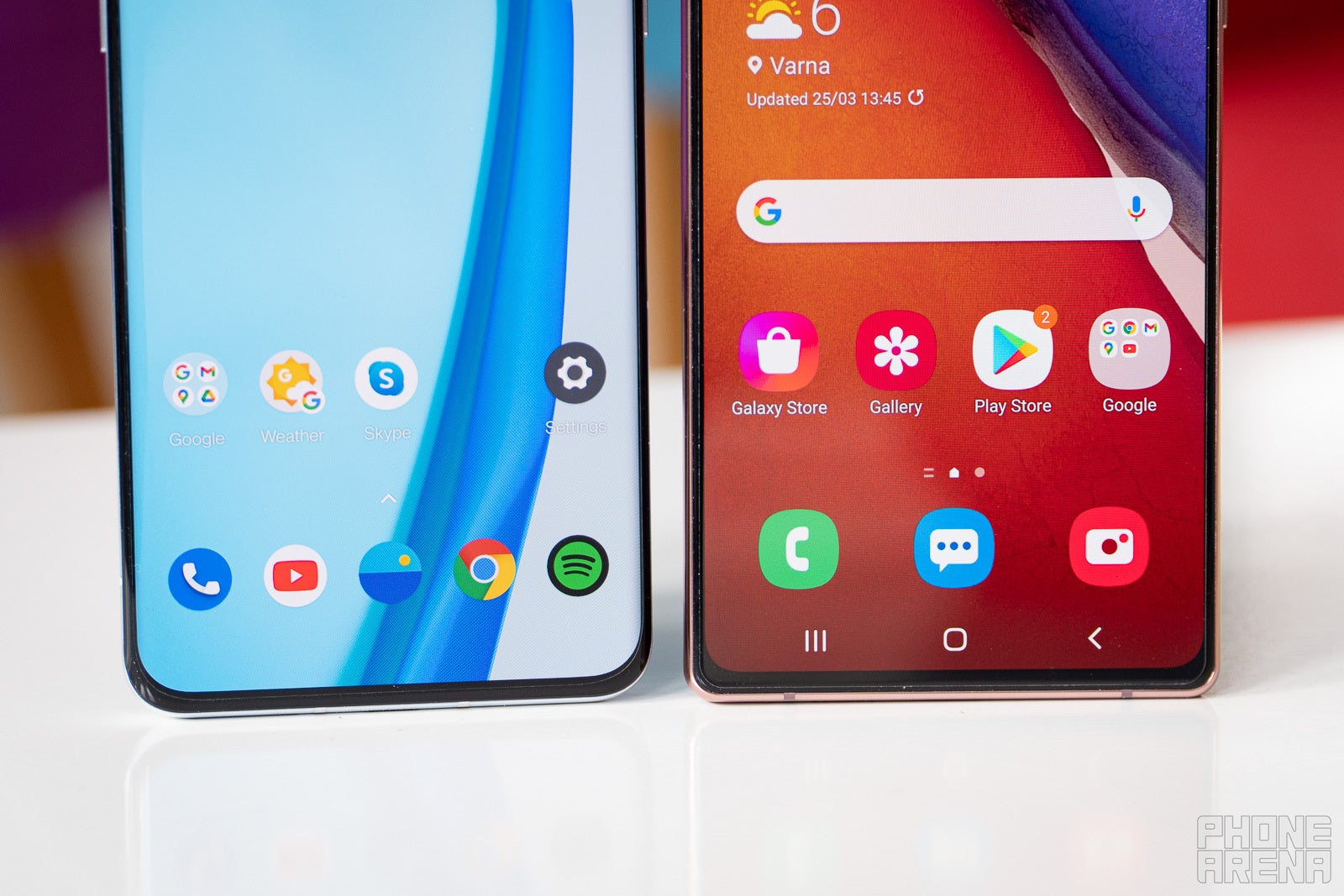
OnePlus 9 Pro display specs
Galaxy Note 20 display specs
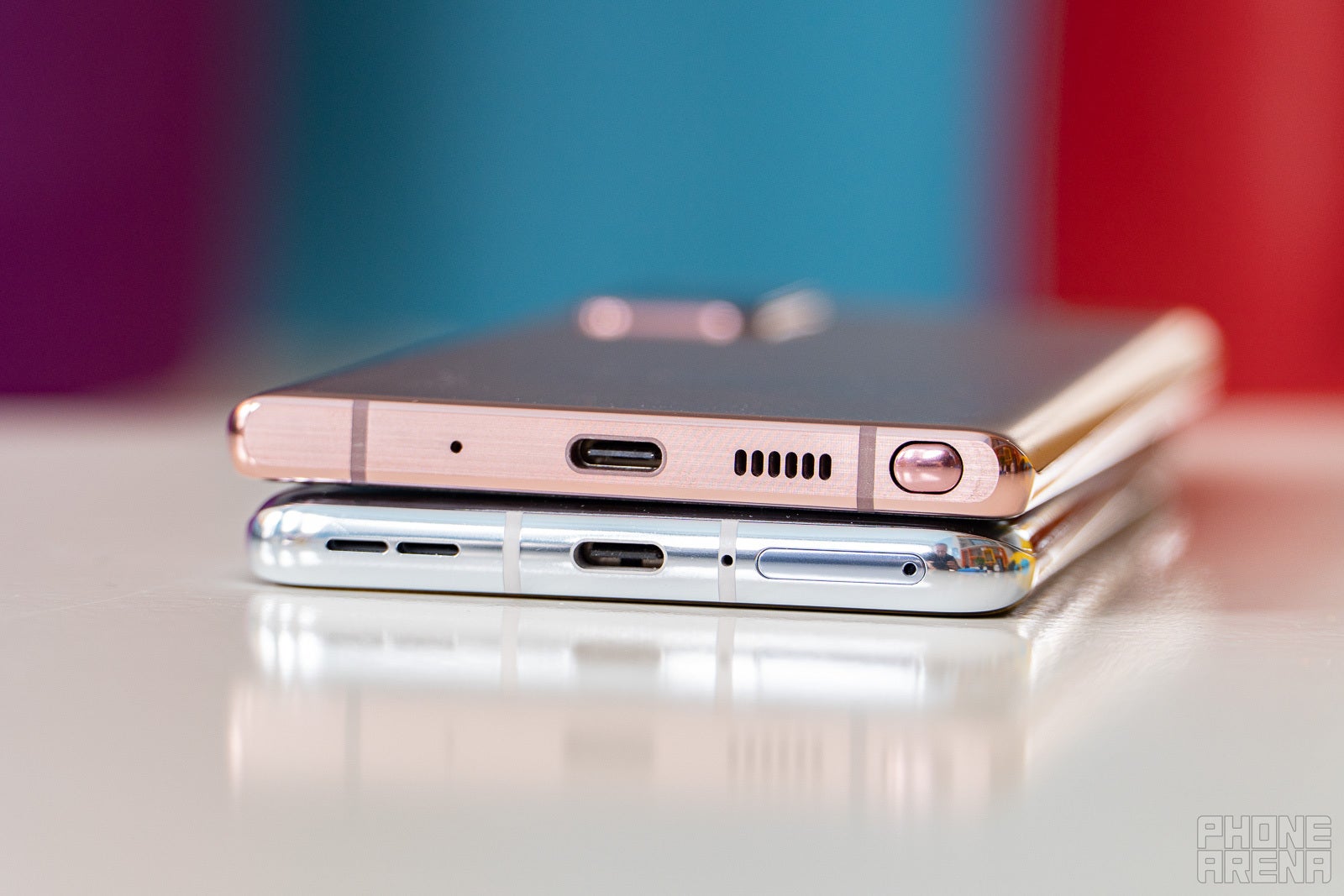
In our recent OnePlus 9 Pro review we were impressed with its high performance, which is to be expected from a high-spec 2021 flagship. The OnePlus 9 Pro has 12 GB of RAM and is powered by the new Snapdragon 888 processor. In our performance tests it easily beat even the Galaxy Note 20 Ultra, let alone the Note 20 itself.
The Galaxy Note 20 is no slouch, but it's still a mid-2020 phone, running on the older Snapdragon 865+ processor and packing less RAM – 8 GB. But while its not quite on the same level as the OnePlus 9 Pro, the Note 20 is still a perfect performer when it comes to 3D gaming or most other tasks.
Choosing between the two shouldn't really come down just to their performance, as both flagships will serve their users well for years to come. The OnePlus 9 Pro is simply the more future-proof one.
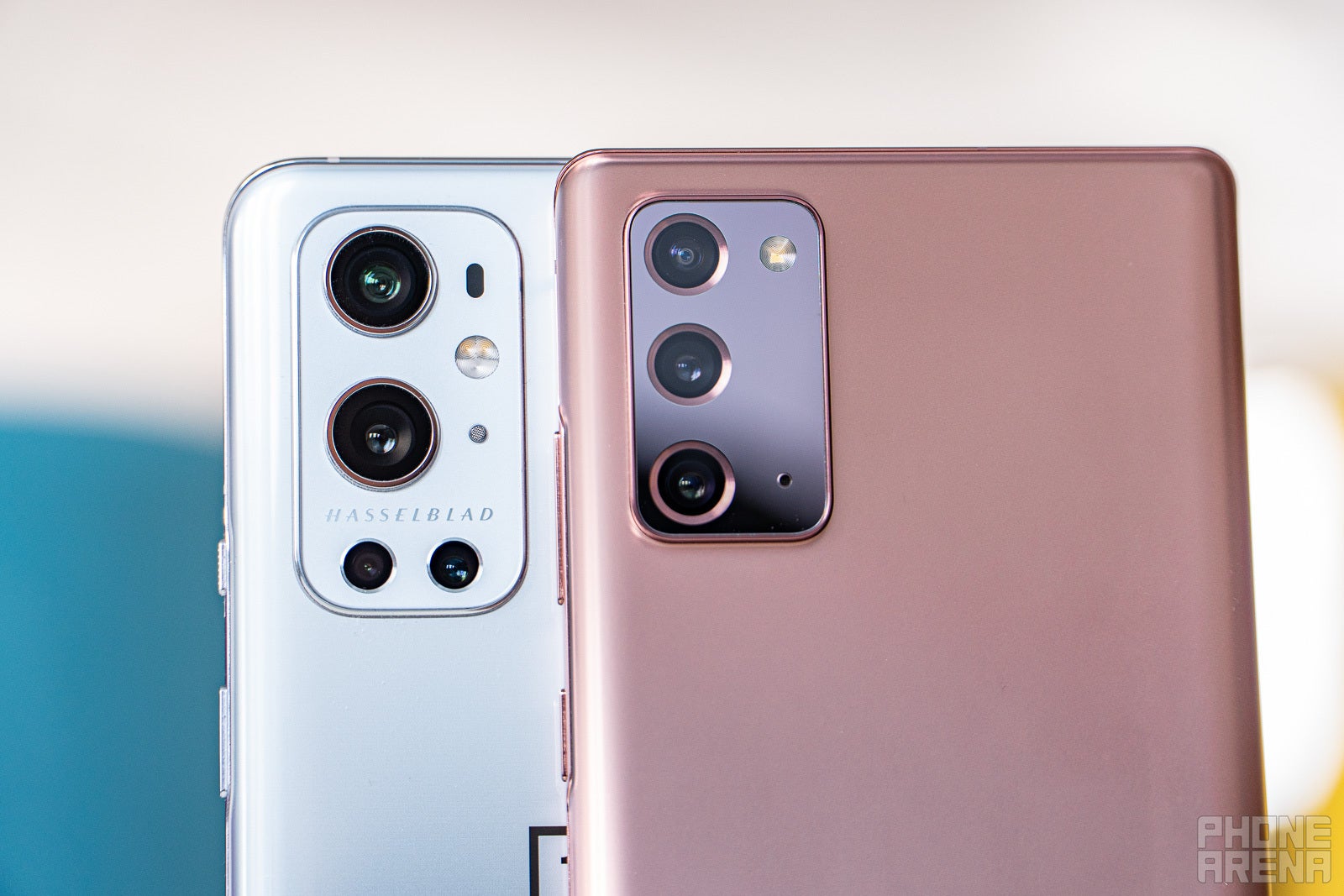
The OnePlus 9 Pro's cameras were notably designed in partnership with legendary camera maker Hasselblad. The phone's main camera is 48 MP (megapixels) and has OIS (optical image stabilization). Additionally there's a 50 MP ultra-wide camera, an 8 MP telephoto one and a 2 MP monochrome sensor.
Photos from the OnePlus 9 Pro's camera come out detailed and with great dynamic range. Portrait shots also look good and so do nighttime shots, where the phone still manages to produce bright and clear images.
When it comes to video recording, the OnePlus 9 Pro is notably the first phone to shoot 4K video at 120 FPS (frames per second), or up to 8K at 30 FPS. In addition, this phone has a neat portrait video feature. Below is a OnePlus 9 Pro video sample at 4K resolution, 30 FPS.

As for the Galaxy Note 20, its main camera is 12 MP and also has OIS, so does its 64 MP telephoto camera. Additionally, this phone also sports a 12 MP ultra-wide camera.
Photos from the Note 20 look fantastic too, with similarly great dynamic range and detail. And like the OnePlus 9, the Note 20 supports portrait photography.
As for video recording capabilities, the Note 20 also supports up to 8K resolution but at 24 FPS. At 4K or lower resolutions, it can film at 60 FPS too, though. Below is a video sample from the Galaxy Note 20 at 4K, 30 FPS.

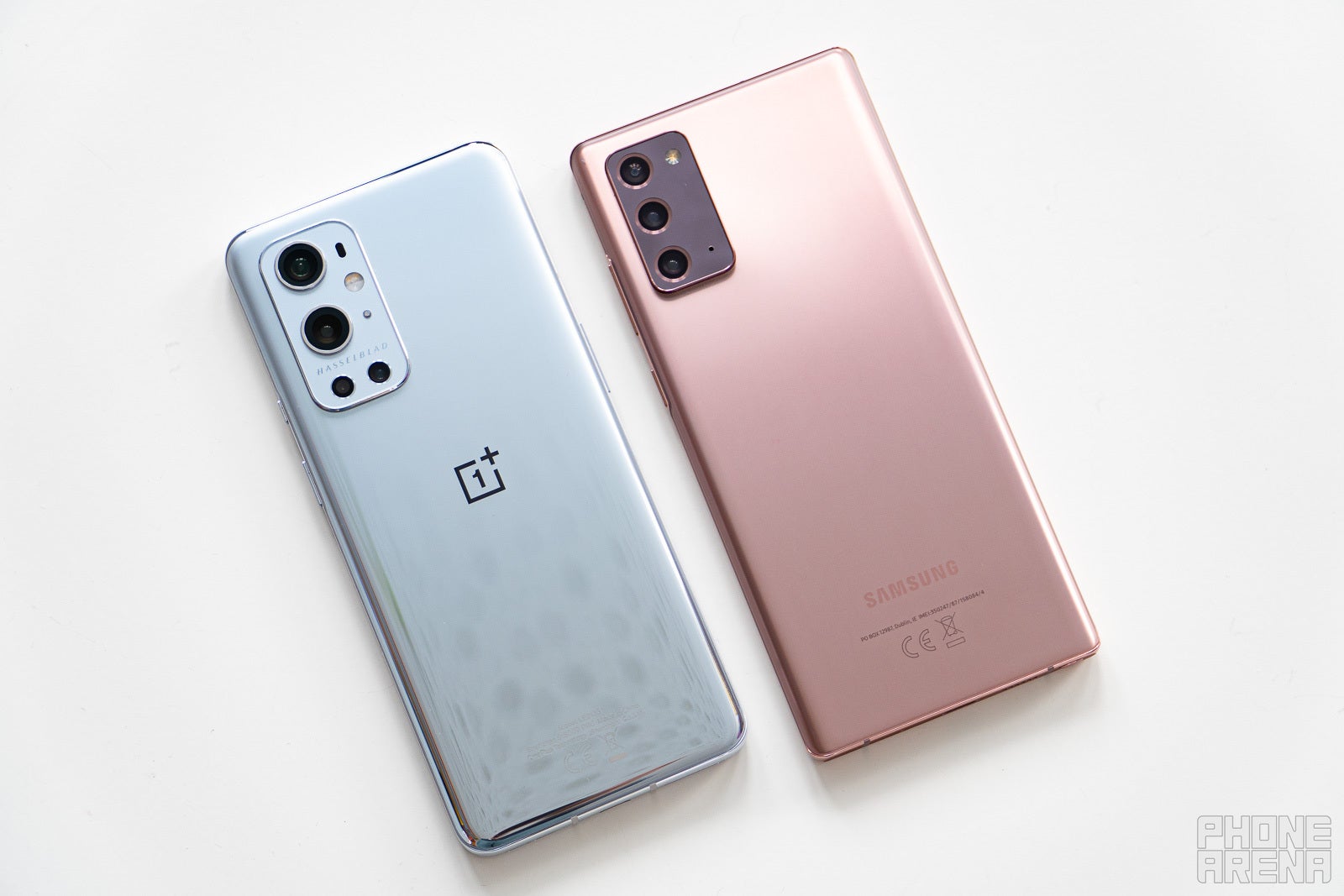
The OnePlus 9 Pro is packing a 4500 mAh battery and is capable of the impressive 65W wired charging and 50W wireless charging. In our OnePlus 9 Pro review we concluded that although this isn't a two-day phone, especially if you're a heavy user, charging it up from zero to 100% takes just about 30 minutes, which is handy. Even when charging it wirelessly with OnePlus' newest 50W wireless charger, topping it up takes just about 43 minutes.
The Galaxy Note 20 has a smaller 4300 mAh battery and supports the slower 25W wired charging speed. It too can charge wirelessly, but only at 10W. In our review of the Note 20, it also didn't prove to be quite a battery champ, but it's an all-day phone nonetheless.
Both phones come with charging bricks out the box.
You may also find interesting:
OnePlus 9 Pro vs Galaxy Note 20 price
The OnePlus 9 Pro with 256GB of storage can be purchased from OnePlus' website for $1,069.
The Samsung Galaxy Note 20 is currently selling for less – $999.99.
OnePlus 9 Pro vs Galaxy Note 20 design

The OnePlus 9 Pro (left) and Galaxy Note 20 (right)
The OnePlus 9 Pro sports a fairly safe modern 2021 design, with minimal bezels around the display and a small hole punch selfie camera in its top left corner. On the back, its rather large Hasselblad-branded camera module catches the eye, but there's not much else but a OnePlus logo for flare.
The OnePlus 9 Pro features rounded corners all around, weighs just about 197 grams, and is glass on both sides, with a metal frame. Its color options are Stellar Black, Pine Green, and Morning Mist, all glossy.

The OnePlus 9 Pro (left) and Galaxy Note 20 (right)
The Samsung Galaxy Note 20 too sports minimal bezels around the display and a small, centered hole punch selfie camera. Its back is a bit more lowkey and matte, although it too has an eye-catching camera module.
In terms of weight, the Galaxy Note 20 is actually the lighter phone out of the two, at 194 grams. Its plastic on the back and glass on the front, and comes in the following colors: Mystic Gray, Mystic Bronze, Mystic Green, Mystic Red.
OnePlus 9 Pro vs Galaxy Note 20 display

The OnePlus 9 Pro (left) and Galaxy Note 20 (right)
The OnePlus 9 Pro has a 6.7-inch 120 Hz AMOLED display made by none other than Samsung, with a resolution of 3216 x 1440 pixels. The display is protected by Gorilla Glass and is satisfyingly sharp, vivid and bright. Its display refresh rate is actually variable, so to save on battery, it can dynamically change from 120 Hz all the way down to 1 Hz.

The OnePlus 9 Pro (left) and Galaxy Note 20 (right)
Samsung's Galaxy Note 20 comes with a 6.7-inch Super AMOLED display, but its refresh rate is the more average 60 Hz, and its resolution is lower – 2400 x 1080. The Note 20's screen too is covered with Gorilla Glass, but isn't as sharp as the OnePlus 9 Pro's screen, due to having less pixels per inch.
OnePlus 9 Pro display specs
- Display resolution: 3216 x 1440 pixels
- Refresh rate: 120 Hz
- Technology and size: AMOLED, 6.7-inch
- Pixels per inch: 525 PPI
Galaxy Note 20 display specs
- Display resolution: 2400 x 1080 pixels
- Refresh rate: 60 Hz
- Technology and size: AMOLED, 6.7-inch
- Pixels per inch: 393 PPI
As can be seen from the measurements above, the OnePlus 9 display is also the brighter out of the two.
OnePlus 9 Pro vs Galaxy Note 20 performance

The OnePlus 9 Pro (bottom) and Galaxy Note 20 (top)
In our recent OnePlus 9 Pro review we were impressed with its high performance, which is to be expected from a high-spec 2021 flagship. The OnePlus 9 Pro has 12 GB of RAM and is powered by the new Snapdragon 888 processor. In our performance tests it easily beat even the Galaxy Note 20 Ultra, let alone the Note 20 itself.
Choosing between the two shouldn't really come down just to their performance, as both flagships will serve their users well for years to come. The OnePlus 9 Pro is simply the more future-proof one.
OnePlus 9 Pro vs Galaxy Note 20 camera

When it comes to video recording, the OnePlus 9 Pro is notably the first phone to shoot 4K video at 120 FPS (frames per second), or up to 8K at 30 FPS. In addition, this phone has a neat portrait video feature. Below is a OnePlus 9 Pro video sample at 4K resolution, 30 FPS.

As for the Galaxy Note 20, its main camera is 12 MP and also has OIS, so does its 64 MP telephoto camera. Additionally, this phone also sports a 12 MP ultra-wide camera.
Photos from the Note 20 look fantastic too, with similarly great dynamic range and detail. And like the OnePlus 9, the Note 20 supports portrait photography.
As for video recording capabilities, the Note 20 also supports up to 8K resolution but at 24 FPS. At 4K or lower resolutions, it can film at 60 FPS too, though. Below is a video sample from the Galaxy Note 20 at 4K, 30 FPS.

OnePlus 9 Pro vs Galaxy Note 20 battery life and charging

The OnePlus 9 Pro is packing a 4500 mAh battery and is capable of the impressive 65W wired charging and 50W wireless charging. In our OnePlus 9 Pro review we concluded that although this isn't a two-day phone, especially if you're a heavy user, charging it up from zero to 100% takes just about 30 minutes, which is handy. Even when charging it wirelessly with OnePlus' newest 50W wireless charger, topping it up takes just about 43 minutes.
The Galaxy Note 20 has a smaller 4300 mAh battery and supports the slower 25W wired charging speed. It too can charge wirelessly, but only at 10W. In our review of the Note 20, it also didn't prove to be quite a battery champ, but it's an all-day phone nonetheless.
OnePlus 9 Pro vs Galaxy Note 20 extended specifications
|
|
|
| OnePlus 9 Pro | Samsung Galaxy Note 20 |
| Dimensions | |
|---|---|
| 6.43 x 2.90 x 0.34 inches 163.2 x 73.6 x 8.7 mm |
6.36 x 2.96 x 0.33 inches 161.6 x 75.2 x 8.3 mm |
| Weight | |
| 6.95 oz / 197.0 g | 6.84 oz / 194.0 g |
| Materials | |
| Back: Glass (Corning Gorilla Glass) | Back: Plastic |
| Resistance | |
| Water, Dust; IP68 | Water, Dust; IP68 |
| Biometrics | |
| 2D Face unlock, Optical in-screen fingerprint | 2D Face unlock, Ultrasonic in-screen fingerprint |
| Features | |
| Stylus | |
| Keys | |
| Left: Volume control; Right: Lock/Unlock key, Other | Right: Volume control, Lock/Unlock key |
| Colors | |
| Morning Mist, Forest Green, Stellar Black | Mystic gray, Mystic bronze, Mystic green, Mystic red |
| Size | |
|---|---|
| 6.7-inch, 89.79% screen-to-body | 6.7-inch, 89.23% screen-to-body |
| Type | |
| AMOLED, 120Hz, HDR | Super AMOLED Plus, 60Hz, HDR |
| Resolution | |
| 3216x1440px, 20.1:9 ratio, 526 PPI | 2400x1080px, 20:9 ratio, 393 PPI |
| Protection | |
| Corning Gorilla Glass | Corning Gorilla Glass 5 |
| System chip | |
|---|---|
| Snapdragon 888 (5 nm) | Snapdragon 865+ SM8250-AB (7 nm) |
| Processor | |
| Octa-core Kryo 680 |
Octa-core 1x3.1GHz Kryo 585 3x2.42GHz Kryo 585 4x1.80GHz Kryo 585 |
| GPU | |
| Adreno 660 | Adreno 650 |
| Memory | |
| 8GB (LPDDR5)/128GB (UFS 3.1) 12GB/256GB |
8GB (LPDDR5)/128GB (UFS 3.0) 8GB/256GB |
| Storage expansion | |
| not expandable | not expandable |
| OS | |
| Android (11) | Android (13, 12, 11, 10) |
| Type | |
|---|---|
| 4500 mAh | 4300 mAh, Li - Polymer |
| Charging | |
| OnePlus Warp Charge Qi wireless charging |
Qualcomm Quick Charge 2.0, Samsung Adaptive Fast Charging Qi and Powermat wireless charging, Reverse wireless charging |
| Charge speed | |
| Wired: 65.0W Wireless: 50.0W |
|
| Rear | |
|---|---|
| Quad camera | Triple camera |
| Main camera | |
| 48 MP (OIS, PDAF) Aperture size: F1.8 Focal length: 23 mm Sensor size: 1/1.4" Pixel size: 1.12 μm |
12 MP (OIS, PDAF) Aperture size: F1.8 Focal length: 26 mm Sensor size: 1/1.76" Pixel size: 1.8 μm |
| Second camera | |
| 50 MP (Ultra-wide) Aperture size: F2.2 Focal Length: 14 mm Sensor size: 1/1.56" |
12 MP (Ultra-wide, Autofocus) Aperture size: F2.2 Focal Length: 13 mm Sensor size: 1/2.55" Pixel size: 1.4 μm |
| Third camera | |
| 8 MP (Ultra-wide) Optical zoom: 3.3x Aperture size: F2.4 Focal Length: 77 mm Pixel size: 1 μm |
64 MP (Telephoto, OIS, PDAF) Aperture size: F2.0 Focal Length: 27 mm Sensor size: 1/1.7" Pixel size: 0.8 μm |
| Fourth camera | |
| 2 MP (Black and White) | |
| Flash | |
| Dual LED | LED |
| Video recording | |
| 8K UHD (30 fps), 4K UHD (120 fps), 1080p (240 fps), 720p (480 fps) OIS, HDR, Continuous autofocus, EIS | 8K UHD (24 fps), 4K UHD (60 fps), 1080p (240 fps), 720p (960 fps) OIS, HDR, Time-lapse video, Hyperlapse, Object tracking, EIS |
| Front | |
| 16 MP (EIS) | 10 MP (PDAF, HDR) Video capture: 4K UHD |
| Bluetooth | |
|---|---|
| 5.2 | 5.0 |
| WLAN | |
| a,b,g,n,ac,Wi-Fi 6,dual-band MIMO, Wi-Fi Direct, Hotspot 802.11 a, b, g, n, ac, ax | a,b,g,n,ac,Wi-Fi 6,dual-band MIMO, Wi-Fi Direct, Hotspot 802.11 a, b, g, n, ac, ax |
| USB | |
| Type-C, USB 3.1 | Type-C, USB 3.2 |
| Sensors | |
| Accelerometer, Gyroscope, Compass, Ambient light sensor, Proximity sensor | Accelerometer, Gyroscope, Compass, Hall (for flip covers), Barometer, Ambient light sensor, Proximity sensor |
| Hearing aid compatible | |
| M3/T3 | |
| Location | |
| GPS, A-GPS, Glonass, Galileo, BeiDou, Cell ID, Wi-Fi positioning | GPS, A-GPS, Glonass, Galileo, Cell ID, Wi-Fi positioning |
| Other | |
| NFC | NFC, ANT+ |
| Headphones | |
|---|---|
| No 3.5mm jack | No 3.5mm jack |
| Speakers | |
| Earpiece, Loudspeaker, Multiple speakers | Earpiece, Multiple speakers |
| Features | |
| Dolby Atmos | 32-Bit DAC, Dolby Atmos, aptX, Dolby Digital, Dolby Digital Plus |
| Screen mirroring | |
| Wireless screen share | |
| Radio | |
| FM | |
| Additional microphone(s) | |
| Noise cancellation | |
| 5G Bands | |
|---|---|
| n1, n2, n3, n5, n7, n8, n20, n25, n28, n38, n40, n41, n48, n66, n71, n77, n78, NSA | n2, n5, n12, n25, n41, n66, n71, n260, n261, SA, NSA, Sub-6, mmWave |
| LTE Bands | |
| 1, 2, 3, 4, 5, 7, 8, 12, 13, 17, 18, 19, 20, 25, 26, 28, 30, 32, 66, 71 | 1, 2, 3, 4, 5, 7, 8, 12, 13, 14, 18, 19, 20, 25, 26, 28, 29, 30, 66 |
| TDD Bands | |
| 38, 39, 40, 41, 46, 48 | 38, 39, 40, 41, 46, 48 |
| 3G Bands | |
| 1, 2, 4, 5, 8, 9, 19 | 1, 2, 4, 5, 8 |
| Data Speed | |
| LTE-A Pro Cat 20 (2000/150 Mbit/s), HSDPA+ (4G) 42.2 Mbit/s, HSUPA 5.76 Mbit/s, UMTS | LTE-A Pro Cat 20 (2000/150 Mbit/s), HSDPA+ (4G) 42.2 Mbit/s, HSUPA 5.76 Mbit/s |
| SIM type | |
| Nano SIM | Nano SIM |
| HD Voice | |
| Yes | |
| FCC approval | |
|---|---|
| Date approved: Mar 24, 2021 FCC ID value: 2ABZ2-EF14A | Date approved: Jul 22, 2020 FCC ID value: A3LSMN981U |
| Measured SAR | |
| Head: 1.19 W/kg Body: 0.75 W/kg Simultaneous Transmission: 1.52 W/kg Wireless Router: 1.19 W/kg |
Head: 0.41 W/kg Body: 0.92 W/kg Simultaneous Transmission: 1.59 W/kg Wireless Router: 1.22 W/kg Phablet: 3.99 W/kg |
| Officially announced | |
|---|---|
| Mar 23, 2021 | Aug 05, 2020 |
| Prices (MSRP) | |
| 8GB/128GB - $969 | $1000 |
See the full
OnePlus 9 Pro vs Samsung Galaxy Note 20 specs comparison
or compare them to other phones using our
Phone Comparison tool
Follow us on Google News




























Things that are NOT allowed:
To help keep our community safe and free from spam, we apply temporary limits to newly created accounts: